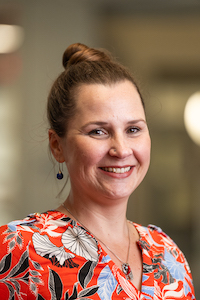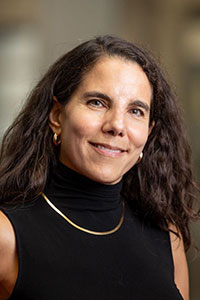Ana Caroline Paiva Gandara, an assistant scientist in the Drummond-Barbosa Lab, has built her career on the metaphorical “backbone” of insects. Most recently, she’s turned to Drosophila melanogaster, commonly known as the fruit fly — a powerful model organism that has contributed to many fundamental research discoveries.

“The fact that Drosophila research has all these genetic tools, it opens the possibility to think about science more easily,” she says. “You can have the craziest idea to explore, and with Drosophila, it’s not infinite, but it offers a very wide world of options.”
In new research published recently in the journal Scientific Reports, Gandara and Drummond-Barbosa describe how chronic exposure to warm temperatures causes infertility in adult male Drosophila.
“The idea that temperature affects reproduction is definitely not new, but most studies come from an ecological point of view,” says Gandara. “We know that the number of eggs is affected, the hatching rates are affected, but why? What is happening inside that is causing this?”
Drummond-Barbosa specializes in studying the cell biology of Drosophila, but with a focus on oogenesis, the development of reproductive egg cells. Gandara’s first publication with the lab explored the effects of temperature within this context, but she saw the opportunity to also look at the effects on spermatogenesis when they observed that males were also becoming sterile at warmer temperatures.
This work continues Gandara’s interest in studying thermal stress on insect physiology, particularly reproductive development. With the increasing impacts of climate change on natural ecosystems, the effect on fertility is a potential factor that could contribute to an organism’s survival or extinction.

“We don’t need super high temperatures to affect an imbalance in the ecosystem that could cause extinction. The flies don’t need to die, they just need to be sterile,” Gandara says. “We have all this research on extreme, lethal temperatures, but if the discussion is in the context of climate change, then more studies on chronic exposure to suboptimal temperatures are necessary.”
Gandara and Drummond-Barbosa concluded from this study that there are two factors that contribute to infertility in Drosophila when exposed to warm, suboptimal temperatures: males develop less sperm and the sperm were of poor quality.
Spermatogenesis is the initial stage of sperm development, where germline stem cells divide and develop into 64-cell cysts, called spermatids. These spermatids then later undergo morphological changes and differentiate into their final sperm cell form before settling in the seminal vesicle where they rest until mating/fertilization.
At 29°C, the researchers observed reduced sperm numbers within five days when compared to flies incubated at the control temperature of 25°C. By 20 days, there were less than 10 sperm found in about half of the seminal vesicles they sampled.
“And in the end, we wanted to know if these sperm had good quality, because there is still sperm there, and we thought there might be an increase in unfertilized eggs to show a problem in fertilization,” Gandara adds. “But most of the eggs were fertilized — the embryo just didn’t develop. Which suggests is that the quality of the sperm is impaired.”
She further explains that there were no significant changes during the process of dividing from germline stem cells into the 64-cell spermatids, and that they suspect defects are likely introduced in the late stages of sperm differentiation.
“We found in both papers in oogenesis and spermatogenesis, that the number of germline stem cells was not affected by 29°C,” she says. “Which could explain the lower fertility, but it’s not the case — I want to know why.”
Gandara’s curiosity and pursuit of big science questions goes back to when she was around 13 years old, and her science teacher brought a microscope to class. She remembers being amazed at the tiny living organisms swimming around and declared, “I want to study this!”
That moment of mentorship inspired her passion for mentoring students throughout her career, and she hopes to move on in the next few years and develop her own lab as a PI.
“I’m in a phase in my career where I’m transitioning,” she laughs when asked about finding the balance between working on experiments herself and working with training students. “I do like being in the lab, especially if it means going to the microscope. It’s still the best!”
